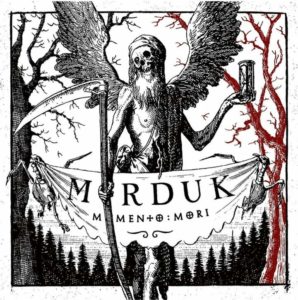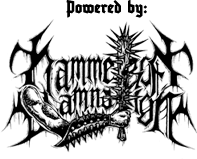 A Black Metal band with over three decades of experience, fifteen studio albums in their discography, and featuring the iconic members Daniel “Mortuus” Rostén and Morgan Hakansson in their lineup undoubtedly grasp the essence of the genre. They most likely know precisely how to craft a sonic expression within their music that invokes and conveys chaos, destruction, death, and desolation. These four elements are precisely what will linger in your mind after you finish listening to “Memento Mori,” the fifteenth album by the Swedish Black Metal band Marduk.
A Black Metal band with over three decades of experience, fifteen studio albums in their discography, and featuring the iconic members Daniel “Mortuus” Rostén and Morgan Hakansson in their lineup undoubtedly grasp the essence of the genre. They most likely know precisely how to craft a sonic expression within their music that invokes and conveys chaos, destruction, death, and desolation. These four elements are precisely what will linger in your mind after you finish listening to “Memento Mori,” the fifteenth album by the Swedish Black Metal band Marduk.
Following two albums focused on themes of warfare, “Frontschwein” (2015) and “Viktoria” (2018), 2023 witnesses the band releasing a work that centralizes around death and the perception of mortality, as evident from its title, “Memento Mori” (Latin for “Remember death”). The album’s opening track, precisely titled “Memento Mori,” encapsulates the sound you will encounter throughout the subsequent nine tracks. It features morbid passages, ultra-fast moments, and even space for experimentation, as evidenced by the dark ambient/industrial tone at the beginning of this track and its ending with chord arrangements sans drums, which I personally found intriguing.
The subsequent track, “Heart of the Funeral,” is undoubtedly my favorite composition on the entire album. It embodies everything I seek in the extreme style: a devastating doublebass drum, powerful guitars with a sense of melody that manages to evoke feelings of fury and contempt for one’s surroundings, and the distinctive vocals of Mortuus, layered and textured in a way that might go unnoticed upon a less attentive listen. Pay attention to how he emphasizes the “R” sounds in his words in this composition, adding more impact to his interpretation. Here, I’d like to emphasize the brilliance of this vocalist, who, in my view, is one of the artists who comprehends Black Metal the most and personifies it across all projects and bands he’s involved in.
The next track, “Blood of The Funeral,” is an extremely fast and frenetic composition with some of the most chaotic riffs the band has ever written. It incorporates keyboard incursions that add a strong dramatic quality and a bombastic atmosphere to the music. “Shovel Beats Sceptre” follows, showcasing the other side of the spectrum within what I seek in Black Metal. It’s a mid-tempo track, more morbid and obscure, with an epic element in its arrangements, guitar work, and especially its vocals, at times bringing to mind Mortuus’ other band, Funeral Mist.
Continuing the listening journey, “Charlatan” seamlessly blends extremely violent moments with some more paced passages. The bass work of guest bassist Devo stands out here, especially given the recent dismissal of the previous bassist, Joel Lindstrom, due to controversies. Devo’s precise and well-utilized bass playing also shines in “Coffin Carol,” likely the fastest track on the album. In the following track, “Marching Bones,” there’s a very specific moment that seemed like a direct reference to the band Mayhem. Perhaps a tribute? Listen and tell me if I’m going crazy.
Both “Marching Bones” and the next track, “Year of the Maggot,” highlight the versatility and creativity of the drummer Simon Schilling (formerly of Panzerchrist and Belphegor) with his insane fills. Pay attention, especially, to the rhythm patterns in “Year of The Goat,” which deviate slightly from the norm. This track also incorporates a touch of dark ambient/industrial elements that fit perfectly.
“Red Tree of Blood” follows, another exceedingly fast track that aptly represents the band’s violent side. The closing track, the ominous “As We Are,” carries a slightly more melancholic undertone, with a slower pace that never strays far from the band’s typical sound. It effectively helps to ease the adrenaline and anger that the album as a whole manages to evoke. “As We Are” even features the distorted vocals of the iconic and late L.G. Petrov, adding to its grandeur.
The production feels more organic compared to Marduk’s recent works and was once again handled by Devo, as previously mentioned, at the Endarker Studio in Sweden. The minimalist black and white album cover, with subtle red accents, is visually striking, capturing not only the concepts explored in the work but also the morbid fascination with death that the band embodies.
For me, Morgan Hakansson and his comrades have nothing subpar in their discography, but unquestionably, “Memento Mori” surpasses the band’s recent releases. I would rank it among the top three best works by Marduk. In a history filled with excellent albums, “Memento Mori” can be considered a high point. Of course, I highly recommend it!
*Review made by J.Adrah Melech













